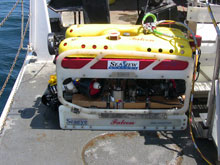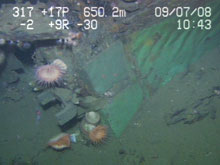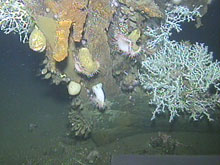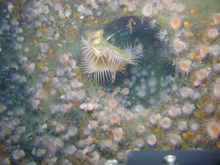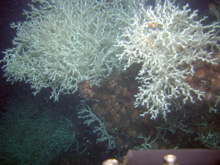Sea Eye Falcon remotely-operated vehicle (ROV) on the deck of the Nancy Foster. Click image for larger view and image credit.
Gudgeon and pintle attached to the sternpost of the Ewing Banks Wreck. The Gudgeon and pintle once secured the rudder to the sternpost. The rudder is no longer attached. Click image for larger view and image credit.
The bow of the Ewing Banks Wreck, covered with Lophelia coral, sea anemones, barnacles, and rusticles (microbial concretions). Click image for larger view and image credit.
Rigs, Reefs, and Wrecks: 2008 - Summary of Leg 1
September 29, 2008
John Broadwater
NOAA's Office of National Marine Sanctuaries
Robert Church
C & C Technologies, Inc.
On September 5, during the first leg of this year’s project, a team of archaeologists and biologists embarked on a cruise aboard the NOAA Research Vessel Nancy Foster to investigate eight shipwreck sites in the Gulf of Mexico. The primary goal was to assess the archaeological and biological potential of each shipwreck site for inclusion in the next phase of the project, scheduled for spring 2009. Our plans called for investigating five unexplored shipwrecks sites and returning to previously explored wrecks, including two 19th century sailing vessels and a World War II U-boat victim. The cruise was exciting and productive, despite the intrusion of two major hurricanes.
Initially, we transited from Galveston, Texas, to a wreck 24 hours away in the Ewing Bank Area. Our Sea Eye Falcon DR remotely-operated vehicle (ROV) was our only means for examining shipwrecks in the deep, dark waters of the Gulf, far beyond the realm of scuba diving. For this cruise, the Falcon was equipped with high-resolution still and video cameras and powerful lights that gave us a continuous, live color view and the ability to record each site in detail.
Our first ROV dive began at 8:40 p.m. on September 6. After nearly an hour of descending into ever-deeper and colder water, the Falcon reached the seabed at 621 meters (2037 feet) and, using its sonar, began searching for the wreck. At the surface, the Nancy Foster’s navigation and dynamically positioned propulsion systems were constantly adjusting in order to maintain the ROV’s position on the seafloor near the wreck site.
The sonar image of this wreck suggested the possibility that it could be very old. Just after 10:00 p.m. a loud cheer went up from the archaeologists in the science lab as a ship’s hull appeared out of the gloom—a hull with the characteristic features of a wooden coastal vessel possibly as old as 200 years. Very shortly a second cheer was led by the biologists who had just gotten their first glimpse of Lophilia pertusa, the deepwater coral of most interest on this expedition. Our excitement was somewhat dampened by the discovery that the hull appeared to be mostly empty, with no artifacts visible, and most of the wooden hull consumed by shipworms (Teredos). The site retained the shape of the original ship primarily because the copper sheeting that once protected the wood was still in place. In spite of the lack of structure and contents, this wreck can still provide important historical and environmental data.
The next site was the Gulfpenn, a 400-foot-long tanker sunk in 1942 by the German submarine U-506. The ROV maneuvered in poor visibility down the wreck’s port side, where the biologists were pleased to observe vast, thriving colonies of Lophilia. Until this expedition, Gulfpenn was the second best Lophelia site known in the Gulf. Before we reached the bow and got a good examination of the coral colonies in that area of the wreck, a power failure extinguished the lights, making it impossible to continue the survey. During recovery, the ROV’s tether was damaged, leaving us with time-consuming repairs to complete. By this time, Hurricane Ike had entered the Gulf and we were forced to seek shelter in Florida, where we were welcomed at the Pensacola Naval Air Station pier early on September 10.
Finally, at 1 p.m. on Sunday, September 14, we got underway toward a large shipwreck believed to be the Gulfoil, a tanker very similar to the Gulfpenn. At 8:15 the following morning, the ROV entered the choppy water and we were soon looking at the side of a large steel hull. Visibility was poor and the current was strong, making it difficult for the ROV to maneuver. These adverse conditions may have been evidence of the immense volume of water from Ike’s 20-foot storm surge ebbing back toward open sea.
The ROV rose higher, seeking the upper edge of the hull, and all of a sudden we were staring at the ship’s name, nearly obscured by a huge Lophilia garland: GULFOIL! The wreck is now positively identified and appears to possibly have more extensive Lophelia colonies than Gulfpenn. Before we reached the stern, the ROV suffered a total power failure that forced us to abort the dive. Nevertheless, our two major goals—identify the wreck and determine the abundance of Lophilia—were met, so the Nancy Foster moved to the next site while the ROV team worked to repair the vehicle.
Just after 3:00 a.m. on the 16th the ROV was launched over the “Green Lantern Wreck,” an early 19th-century vessel that was first investigated in 2004. The ROV reached the bottom at nearly 945 meters (3,100 feet) and began straining against a very strong current in an effort to reach the wreck in nearly zero visibility. The ROV reached the stern, but it was evident that a close inspection in such poor environmental conditions would endanger the fragile shipwreck.
With time running out, we reluctantly headed for Gulfport, Mississippi, where the Leg 1 team said their thanks and goodbyes to the Foster’s officers and crew. The cruise provided a wealth of new data that will allow the principal scientists to refine their list of sites to be included in future studies.






















